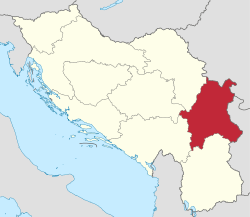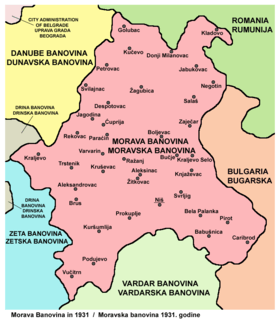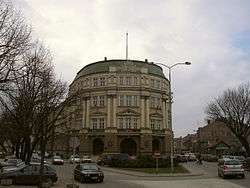Morava Banovina
| Morava Banovina Moravska banovina Моравска бановина | |||||
| Banovina of the Kingdom of Yugoslavia | |||||
| |||||
 Kingdom of Yugoslavia (light yellow) | |||||
| Capital | Niš | ||||
| History | |||||
| • | Established | 1929 | |||
| • | Disestablished | 1941 | |||
| Today part of | Serbia/Kosovo[lower-alpha 1] | ||||

The Morava Banovina or Morava Banate (Serbian: Моравска бановина/Moravska banovina) was a province (banovina) of the Kingdom of Yugoslavia between 1929 and 1941. This province consisted of parts of present-day Central Serbia (including Vučitrn and Podujevo in Kosovo) and it was named for the Morava Rivers. The capital city of the Morava Banovina was Niš.

Borders
According to the 1931 Constitution of the Kingdom of Yugoslavia,
- The Morava Banovina is bounded on the north and the east by the State frontiers with Romania and Bulgaria as for as the southern boundary of the district of Lužnica (at Descani Kladenac). From this point the boundary of the Banovina follows the southern boundaries of the districts of Lužnica, Niš, Dobrić, Prokuplje, Kosanica, Lab and Vučitrn (Vushtrria), including all these districts, and at the intersection of the boundaries of the three districts of Vučitrn, Gračanica and Drenica it joins the boundary of the Zeta Banovina. The boundary then continues northwards, coinciding with the boundaries of the Zeta, Drina, and Danube Banovinas.
History
In 1941, the World War II Axis Powers occupied the Morava Banovina and it was made part of German and Bulgaria -occupied Serbia and Italian-occupied Albania. Following World War II, the region was made a part of Serbia within a federal Socialist Yugoslavia.
Notes and references
Notes:
- ↑ Kosovo is the subject of a territorial dispute between the Republic of Kosovo and the Republic of Serbia. The Republic of Kosovo unilaterally declared independence on 17 February 2008, but Serbia continues to claim it as part of its own sovereign territory. The two governments began to normalise relations in 2013, as part of the Brussels Agreement. Kosovo has received recognition as an independent state from 110 out of 193 United Nations member states.
References:
See also
Coordinates: 43°18′00″N 21°54′00″E / 43.3000°N 21.9000°E